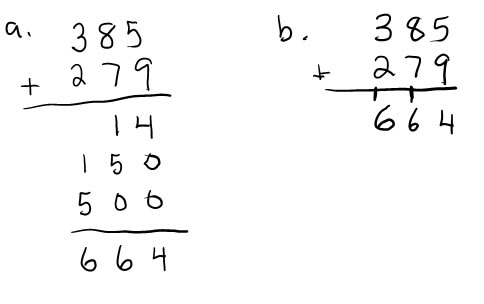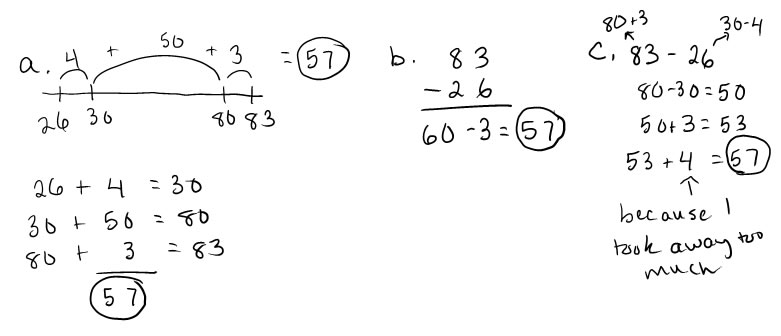a. the the expanded algorithm
b. the British algorithm

If you reload this page, there might be new content on it. Or not. But you could try.
Questions you should know how to answer and that are reasonably likely to appear on the exam:
1. Give examples of groupable/decomposable base 10 materials, pre-grouped proportional and pregrouped non-proportional base 10 materials. Tell what the advantages are of each kind of material. (lesson 3.1)
Notice that you need 3 examples here, each of which you need to be able to say something about:
--Groupable: popsicle sticks and rubber bands. Advantage: hands on experience making 10s and 100s. Can put together and take apart when problem solving.
--pre-grouped proportional: base 10 blocks. Advantages: requires working with tens and ones (and hundreds)--you can't take everything apart into ones. It shows visually the comparison in size between place values.
--pre-grouped non-proportional: coins and money or Montessori stamp game or place value chips. Advantages: more abstract--requires using numbers to hold place value; allows for working problems with larger numbers without it taking too much space.
2. Give some advantages of teaching 2-digit addition by questioning and discussing (lesson 3.2)
-- If you teach with questioning and discussing then you learn more about the children's reasoning, and the children are more likely to understand the strategies and where they come from
3. Give some advantages of teaching 2-digit addition by demonstrating and explaining (lesson 3.3)
--You can teach the standard algorithm which it's good to know, and you can manage the lessons to go in the directions you expect.
4. Explain in words the steps in the standard algorithm (lessons 3.4 and 3.5) for
a. 263 + 182
Add 2 and 3 to get 5. Write 5 in the ones place of the answer
Add 60 and 80 to get 140, which is 14 tens, which is the same as 1 hundred (100) and 4 tens (40). Write 4 in the tens place of the answer, and write 1 (for 100) in the hundreds place above the problem.
Add 200, 100 and 100 (that we got from trading in 10 tens) to get 400. Write 4 in the hundreds place of the answer.
b. 328 - 192
Take away 2 from 8, to get 6. Write 6 in the ones place of the answer.
Think about 20. Can you take 90 away from 20? (If you had 2 ten-sticks, would there be enough to take away 9 ten-sticks)? No, so trade 100 for 10 tens. Change the 3 hundreds in 328 to 2 hundreds, and change the 2 tens in 328 to 12 tens.
Take away 9 tens from 12 tens. That leaves 3 tens. Write 3 in the tens place of the answer.
Take away 1 hundred from 2 hundred. That leaves 1 hundred. Write 1 in the hundreds place of the answer.
lesson 3.4:
Organizing all of these descriptive terms: from 3.4:
The expanded algorithms you just need to learn with that name. Also subtraction with negative numbers you just need to learn with that name.
The student invented algorithms have these things to keep track of:
"using multiples of 10 as bridge numbers" or "bridge with 10" means that you are using numbers that end in 0 as stepping stones to get to the answer. These strategies are usually shown on a number line.
"breaking into place values" or "using place values" means that you should take the number indicated (addend, minuend or subtrahend) and split it into place values like 53=50+3, and you should add or subtract using the 50 and the 3 separately.
"adding on" (for an addition problem) means you start with one addend and then add more (the other addend) on to it.
"adding up to" (for a subtraction problem) means you start with the smaller number (subtrahend) and add on to it until you get to the bigger number (minuend). In this case the difference is the amount you add to get from one to the other. On a number line, you will be going left to right in this process.
"taking away" means that you start with the minuend and take away from it. On a number line, you will be going right to left in this process.
"finding friendly numbers" means that you are "rounding" one or both of the numbers in the problem (it's OK to round either down or up--the rounding rules don't have to apply here). You can fix up a rounded estimage in two ways:
At the beginning--change both numbers: one number becomes a friendly number and the other number changes to keep the answer the same. There are two different versions of this depending on whether you are adding or subtracting.
At the end--add or subtract by the amounts you changed when changing the numbers to friendly numbers.
5. Show how to compute 385 + 279 using:
a. the the expanded algorithm
b. the British algorithm
6. Show how to compute 48 + 24 using:
a. breaking both numbers into place value and adding within place values.
b. adding on in chunks (show with equations and number line)
c. finding friendly numbers and compensating (either version)
(note: my solution to a is essentially the only method that fits the description, but my solutions to b and c are only one of several correct possible strategies).
7. Show how to compute 623 - 184 using
a. the equal additions algorithm.
b. the expanded algorithm (breaking into place values and exchanging)
8. Explain how the trade-first algorithm is different from the standard algorithm for subtraction.
--Look for columns need a trade, and make all trades before doing any subtractions. With this modification, subtraction can be correctly performed left to right as well as right to left.
9. Show how to compute 83 - 26 using:
a. Adding up in chunks using multiples of 10 as bridge numbers (number line and equations)
b. Place value and negative numbers
c. Finding friendly numbers and compensating (any version)

note: my solutions is a and b are pretty much the only ones that fit the instructions, but my solution in c is only one of many acceptable answers.
10. One way of subtracting 72 - 49 is to begin by subtracting 70-40=30.
a.when you adjust this difference to account for the 2 in 72, should you add 2 or subtract 2 from 30? Explain why you add (if you add) or subtract (if you subtract).
You should add because the 2 is part of the original amount. We started off with only 70, which is too small, so we have to put the 2 back in.
b. when you adjust this difference to account for the 9 in 49, should you add 9 or subtract 9 from the result of part a? Explain why you add (if you add) or subtract (if you subtract).
You should subtract the 9 because it's part of the amount that should be taken away. We only took away 40 so far, and we still need to take away the other 9.
Lesson 3.8
11. Given examples of student work, describe the process/algorithm the student is following to get their answers. Decide whether that process leads to consistently correct answers (alternate algorithm) or consistently incorrect answers (error pattern). If it is an error pattern, determine what the key understanding is that is causing problems for the student.
Examples:
This one is an error pattern where the student only makes the error when trading is required in both place values. When trading is required in two place values, the student trades in 1 hundred for 10 tens and 10 ones, which is too much (10 tens + 10 ones is more than 100).
This is an alternate algorithm. The student is adding each place value and then combining.
12. Explain why subtracting across a 0 (as in 403-128) is difficult for children, and write an explanation (as if to a student) of how to do it correctly. (Your explanation should be more than just a set of steps to follow).
13. For an error pattern such as the one in problem 11, describe an intervention that you could use to reteach and correct the error.